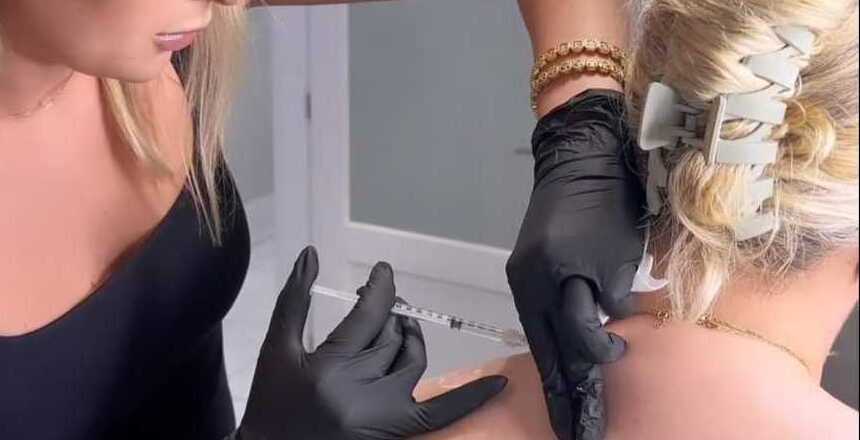If you’re looking for a way to refresh and rejuvenate your skin, chemical peels could be just what you need. These treatments are a popular choice for people who want to improve their skin’s texture, tone, and appearance. But what are chemical peels, and how do they work? In this article, we’ll take you through everything you need to know about chemical peels, including the available types, the benefits and risks, and what to expect during and after treatment.
1. What Are Chemical Peels?
Chemical peels are a type of skin treatment that involves applying a chemical solution to the skin to remove the outer layer of dead skin cells. This process promotes the growth of new, healthy skin cells, resulting in a smoother, brighter complexion. Chemical peels can be used to treat a variety of skin concerns, including acne, fine lines, wrinkles, hyperpigmentation, and sun damage.
2. How Do Chemical Peels Work?
Chemical peels work by using a chemical solution to dissolve the outer layer of dead skin cells on the skin’s surface. This solution typically contains a combination of acids, such as glycolic acid, salicylic acid, and trichloroacetic acid (TCA), which help to break down the bonds between the dead skin cells. As the outer layer of skin is removed, the body’s natural healing process is triggered, and new skin cells are produced to replace the old ones. This results in a smoother, brighter, and more youthful-looking complexion.
3. Types of Chemical Peels
There are three main types of chemical peels: superficial peels, medium peels, and deep peels.
3.1 Superficial Peels
Superficial peels are the mildest form of chemical peel and are usually made with alpha-hydroxy acids (AHAs), such as glycolic or lactic acid. They are designed to remove only the outermost layer of skin and are ideal for people with mild skin concerns or those who are new to chemical peels. Superficial peels are generally well-tolerated and require little to no downtime.
3.2 Medium Peels
Medium peels use a combination of trichloroacetic acid (TCA) and glycolic acid to penetrate deeper into the skin than superficial peels. They are ideal for people with moderate skin concerns, such as fine lines, wrinkles, and age spots. Medium peels require some downtime, as the skin will peel and flake for several days after treatment.
3.3 Deep Peels
Deep peels use a high concentration of trichloroacetic acid (TCA) or phenol to penetrate the deepest layers of the skin. They are ideal for people with severe skin concerns, such as deep wrinkles, sun damage, and scarring. Deep peels require the longest downtime, as the skin can take several weeks to fully heal and regenerate.
4. Who Can Benefit from Chemical Peels?
Chemical peels can benefit almost anyone who wants to improve the appearance and texture of their skin. However, they are particularly effective for people with the following skin concerns:
- Acne and acne scars
- Fine lines and wrinkles
- Uneven skin tone and texture
- Hyperpigmentation and sun damage
- Enlarged pores
- Dull or tired-looking skin
Before undergoing a chemical peel, it is important to consult with a qualified provider to determine if you are a good candidate for the treatment.
5. What Are the Risks and Side Effects?
Like any medical procedure, chemical peels have risks and side effects. Some of the most common side effects include:
- Redness and irritation
- Peeling and flaking
- Sensitivity to the sun
- Temporary hyperpigmentation or hypopigmentation
- Infection or scarring (rare)
To minimize the risk of side effects, choosing a qualified provider and following their instructions for before and after care is important.
6. How to Prepare for a Chemical Peel
Before undergoing a chemical peel, your provider will instruct you on preparing for the treatment. These may include:
- Avoiding certain medications, such as Retin-A and Accutane, for several weeks before treatment
- Using a gentle cleanser and moisturizer in the days leading up to the peel
- Avoiding sun exposure and tanning beds for several weeks before treatment
- Arranging for someone to drive you home after the procedure (if you are receiving a medium or deep peel)
7. What to Expect During a Chemical Peel
During a chemical peel, your provider will apply the chemical solution to your skin using a brush or cotton swab. You may feel a mild burning or stinging sensation during the application. After a few minutes, the solution will be neutralized and removed from your skin.
The length of the procedure will depend on the type of peel you are receiving. Superficial peels typically take 15-20 minutes, while medium and deep peels can take up to an hour.
8. How to Care for Your Skin After a Chemical Peel
After a chemical peel, following your provider’s instructions for aftercare is important. This may include:
- Using a gentle cleanser and moisturizer
- Avoiding sun exposure and wearing sunscreen
- Avoiding makeup and other skincare products for a few days
- Avoiding strenuous exercise and sweating for several days
Your skin may peel and flake for several days after the procedure, so it is important to avoid picking or peeling at the skin.
9. How Often Should You Get a Chemical Peel?
The frequency of chemical peels will depend on your individual skin concerns and goals. Superficial peels can be performed every 4-6 weeks, while medium and deep peels should be spaced out several months apart.
10. How to Choose a Provider
When choosing a provider for your chemical peel, it is important to do your research and choose someone qualified and experienced. Look for providers who:
- Have a medical degree or certification in dermatology or aesthetics
- Have experience performing chemical peels
- Use high-quality, medical-grade products
- Have a good reputation and positive reviews from past clients
Don’t be afraid to ask questions and discuss your concerns with the provider before the treatment.
11. Cost of Chemical Peels
The cost of a chemical peel can vary depending on the type of peel, the provider, and your location. Superficial peels typically cost between $100-$200 per treatment, while medium and deep peels can cost up to $1,000 or more. Some providers may offer package deals or discounts for multiple treatments.
12. FAQs
12.1 What should I do if my skin feels sensitive after a chemical peel?
After a chemical peel, it is normal for your skin to feel sensitive and irritated. To soothe your skin, use a gentle moisturizer and avoid any harsh products or treatments until your skin has fully healed.
12.2 Can I wear makeup after a chemical peel?
It is best to avoid wearing makeup for the first few days after a chemical peel, as your skin may be sensitive and prone to irritation. Once your skin has fully healed, you can resume your normal makeup routine.
12.3 Can I go in the sun after a chemical peel?
After a chemical peel, avoiding sun exposure and wearing sunscreen to protect your skin is important. Your skin may be more sensitive to the sun after a chemical peel, so it is important to take extra precautions to avoid sunburn and other damage.
12.4 Are chemical peels painful?
Chemical peels can cause some mild discomfort and stinging during the application process. However, most people find that the discomfort is temporary and well-tolerated.
12.5 Can I get a chemical peel if I have sensitive skin?
You can still get a chemical peel if you have sensitive skin. However, choosing a gentle peel and working with a qualified provider who can tailor the treatment to your needs is important.
Conclusion
Chemical peels are a popular and effective way to improve the appearance and texture of your skin. Whether you’re looking to treat acne, fine lines, or hyperpigmentation, a chemical peel can help you achieve your goals. By choosing a qualified provider and following their instructions for before and aftercare, you can enjoy smoother, brighter, and more youthful-looking skin.






